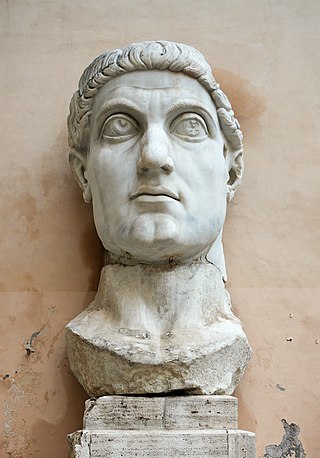
Constantine I, also known as Constantine the Great, was a Roman emperor from AD 306 to 337 and the first Roman emperor to convert to Christianity. He played a pivotal role in elevating the status of Christianity in Rome, decriminalizing Christian practice and ceasing Christian persecution in a period referred to as the Constantinian shift. This initiated the Christianization of the Roman Empire. Constantine is associated with the religiopolitical ideology known as Caesaropapism, which epitomizes the unity of church and state. He founded the city of Constantinople and made it the capital of the Empire, which remained so for over a millennium.

The labarum was a vexillum that displayed the "Chi-Rho" symbol ☧, a christogram formed from the first two Greek letters of the word "Christ" – Chi (χ) and Rho (ρ). It was first used by the Roman emperor Constantine the Great.

The Battle of the Milvian Bridge took place between the Roman Emperors Constantine I and Maxentius on 28 October AD 312. It takes its name from the Milvian Bridge, an important route over the Tiber. Constantine won the battle and started on the path that led him to end the Tetrarchy and become the sole ruler of the Roman Empire. Maxentius drowned in the Tiber during the battle; his body was later taken from the river and decapitated, and his head was paraded through the streets of Rome on the day following the battle before being taken to Africa.

Flavius Valerius Constantius, also called Constantius I, was a Roman emperor from 305 to 306. He was one of the four original members of the Tetrarchy established by Diocletian, first serving as caesar from 293 to 305 and then ruling as augustus until his death. Constantius was also father of Constantine the Great, the first Christian emperor of Rome. The nickname "Chlorus" was first popularized by Byzantine-era historians and not used during the emperor's lifetime.
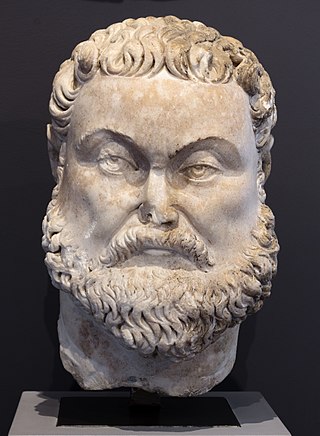
Maximian, nicknamed Herculius, was Roman emperor from 286 to 305. He was Caesar from 285 to 286, then Augustus from 286 to 305. He shared the latter title with his co-emperor and superior, Diocletian, whose political brain complemented Maximian's military brawn. Maximian established his residence at Trier but spent most of his time on campaign. In late 285, he suppressed rebels in Gaul known as the Bagaudae. From 285 to 288, he fought against Germanic tribes along the Rhine frontier. Together with Diocletian, he launched a scorched earth campaign deep into Alamannic territory in 288, refortifying the frontier.

Marcus Aurelius Valerius Maxentius was a Roman emperor from 306 until his death in 312. Despite ruling in Italy and North Africa, and having the recognition of the Senate in Rome, he was not recognized as a legitimate emperor by his fellow emperors.

Flavius Valerius Severus, also called Severus II, was a Roman emperor from 306 to 307, and a member of the Tetrarchy. He shared control of the western half of the empire with Constantine I, but spent most of his short reign in a civil war against the usurper Maxentius, who later killed him and took over Italy.
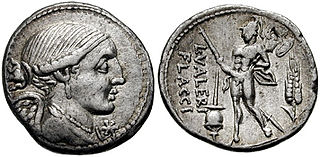
The gens Valeria was a patrician family at ancient Rome, prominent from the very beginning of the Republic to the latest period of the Empire. Publius Valerius Poplicola was one of the consuls in 509 BC, the year that saw the overthrow of the Tarquins, and the members of his family were among the most celebrated statesmen and generals at the beginning of the Republic. Over the next ten centuries, few gentes produced as many distinguished men, and at every period the name of Valerius was constantly to be found in the lists of annual magistrates, and held in the highest honour. Several of the emperors claimed descent from the Valerii, whose name they bore as part of their official nomenclature.

Flavia Maxima Fausta Augusta was a Roman empress. She was the daughter of Maximian and wife of Constantine the Great, who had her executed and excluded from all official accounts for unknown reasons. Historians Zosimus and Zonaras reported that she was executed for adultery with her stepson, Crispus.
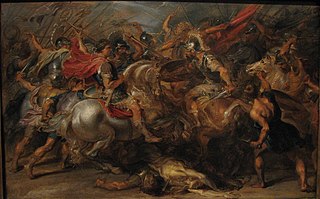
The Battle of Chrysopolis was fought on 18 September 324 at Chrysopolis, near Chalcedon, between the two Roman emperors Constantine I and Licinius. The battle was the final encounter between the two emperors. After his navy's defeat in the Battle of the Hellespont, Licinius withdrew his forces from the city of Byzantium across the Bosphorus to Chalcedon in Bithynia. Constantine followed, and won the subsequent battle. This left Constantine as the sole emperor, ending the period of the Tetrarchy.
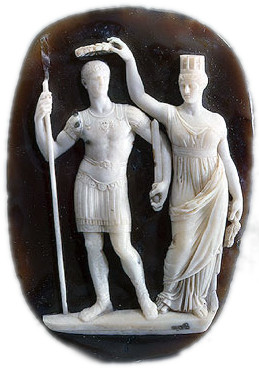
The Battle of Adrianople was fought in Thrace on July 3, 324, during a Roman civil war, the second to be waged between the two emperors Constantine I and Licinius. Licinius was soundly defeated and his army suffered heavy casualties. Constantine built up military momentum, winning further battles on land and sea, eventually leading to the final defeat of Licinius at Chrysopolis.

The Battle of the Hellespont, consisting of two separate naval clashes, was fought in 324 between a Constantinian fleet, led by the eldest son of Constantine I, Crispus; and a larger fleet under Licinius' admiral, Abantus. Despite being outnumbered, Crispus won a very complete victory.

The Battle of Cibalae was fought in 316 between the two Roman emperors Constantine I and Licinius. The site of the battle, near the town of Cibalae in the Roman province of Pannonia Secunda, was approximately 350 kilometers within the territory of Licinius. Constantine won a resounding victory, despite being outnumbered.
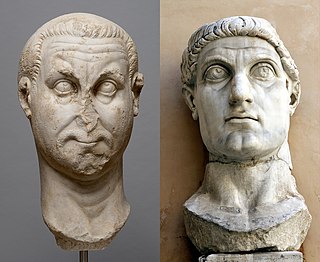
The Battle of Mardia, also known as Battle of Campus Mardiensis or Battle of Campus Ardiensis, was fought in late 316/early 317 between the forces of Roman Emperors Constantine I and Licinius. Its location was probably modern Harmanli (Bulgaria) in Thrace.

Martinian was Roman emperor from July to September 324. He was raised to the purple by the emperor Licinius, whom he had hitherto served as a senior bureaucrat, during Licinius's civil war against the emperor Constantine I. Constantine defeated both emperors and forced them to abdicate, and executed them after initially showing leniency.

Pannonia Superior was a Roman province created from the division of Pannonia in 103 AD, its capital in Carnuntum. It overlapped in territory with modern-day Hungary, Croatia, Austria, Slovakia, and Slovenia.
Bassianus was a Roman senator, whom the Emperor Constantine I arranged to marry his half-sister, Anastasia. In 314 Constantine hoped to elevate Bassianus to the imperial rank of caesar, but Constantine's co-augustus in the East Licinius successfully opposed the move. According to the Anonymus Valesianus, a Latin chronicle composed during late antiquity, Bassianus was accused of plotting against the throne and was executed by Constantine.

The civil wars of the Tetrarchy were a series of conflicts between the co-emperors of the Roman Empire, starting from 306 AD with the usurpation of Maxentius and the defeat of Severus to the defeat of Licinius at the hands of Constantine I in 324 AD.

The German and Sarmatian campaigns of Constantine were fought by the Roman Emperor Constantine I against the neighbouring Germanic peoples, including the Franks, Alemanni and Goths, as well as the Sarmatian Iazyges, along the whole Roman northern defensive system to protect the empire's borders, between 306 and 336.

The siege of Byzantium was carried out some time between July and September 324 by the forces of the Roman emperor Constantine I during his Second Civil War against his rival, co-emperor Licinius. It would have been started simultaneously with the naval battle of the Hellespont in which Constantine's son and caesar Crispus defeated the Lycinian navy commanded by Admiral Abanto.


















